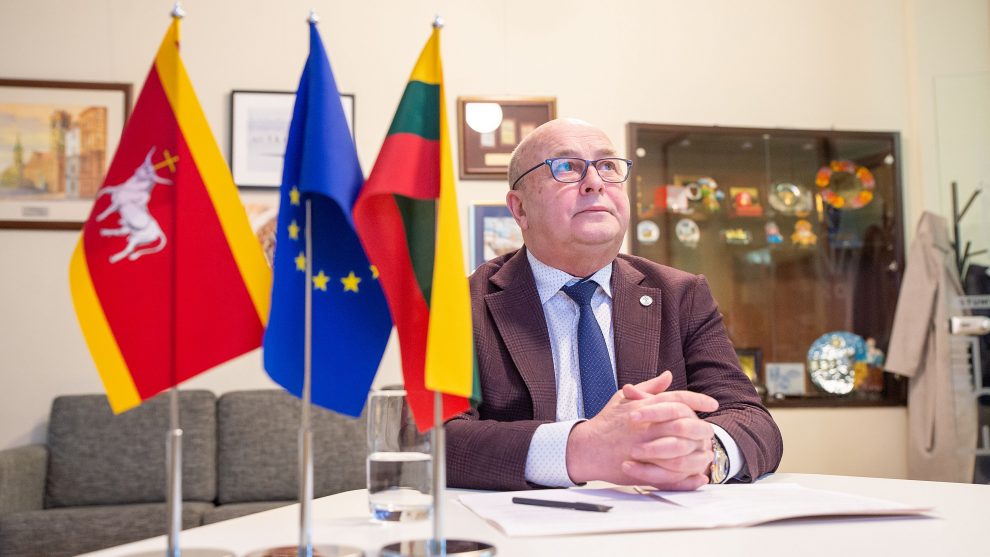In the discussion of the leaders of European regions about the New European Bauhaus – Kaunas best practices

Paskelbta: 2021-05-26 (Wednesday)
The new European Bauhaus is an initiative based on sustainability, accessibility and aesthetics to bring Europe’s green course closer to the people. Visvaldas Matijošaitis together with the leaders of other European Capitals of Culture and European Innovation – Barcelona, Galway, Rijeka, Cork, Esch-sur-Alzette and Leuven – presented today’s examples of Kaunas in the discussion initiated by the European Commission “The new European Bauhaus and its territorial dimension: a conversation changing our world“.
Favorable assessment for Kaunas
“The title of European Capital of Culture 2022, earned a few years ago, is an opportunity to create a second phenomenon – no longer a temporary but a modern capital – to activate the social and economic life of the city through culture. The diverse cultural program emphasizes sustainable design, accessibility for all, and involves urban communities and neighborhoods in creative processes.
In this context, one of the programs can be singled out – Modernism for the Future. Its aim is to strengthen the awareness of citizens in the field of heritage. In addition, Kaunas has been implementing a well-known heritage management program for the seventh year in a row, thanks to which residents appreciate the peculiarity of Kaunas architecture and sustainably renovate their modernist housing,” Kaunas city initiatives were presented by V. Matijošaitis in a remote discussion with regional policy experts.
EU Commissioner for Cohesion Policy and Reform Elisa Ferreira drew attention to the conversion project in Kaunas, which transformed the former military aviation territory into a high-tech valley in the future Aleksotas Innovation Industrial Park. This is an example of how cities have the creative potential to develop their spaces differently in response to the New European Bauhaus concept of long-term sustainable socio-cultural change.
“We see how abandoned, useless spaces can be converted, changed and become attractive. This shows how important they are for an urban development strategy. It is gratifying to hear about such examples, ”said Commissioner Ferreira to the city of Kaunas and other European regional leaders.
At the time, Mariya Gabriel, European Commissioner for Innovation, Research, Culture, Education and Youth, pointed out that such modern Bauhaus-style projects in the cities of the Old Continent had a number of commonalities: „Increasing accessibility by adapting brownfields to new groups of people sets the direction for the future we should go. This synergy is particularly important for cities and entire regions, which will help us to continue to work effectively and strengthen our living environment“.
Public participation is important
Apostolos Tzitzikost, President of the Committee of the Regions, emphasized that the century-old “old” Bauhaus had combined design and function. The new European Bauhaus initiative, launched by European Commission President Ursula von der Leyen, aims to extend this tradition by harmonizing beauty, design, sustainability, culture and social inclusion: “The new European Bauhaus shares similar values: science and technology combine with art and culture. However, this would not be possible without the territorial dimension, which is reflected in dynamic cities and regions. ”
“The ‘green transition’ is particularly significant here. The accessibility of the project is ensured by providing funding from the EU cohesion policy funds. The Committee of the Regions can help to embed the new Bauhaus in the regions and cities. This initiative must become a real movement, not another top-down project.
It is very important that, even at the lowest level, ordinary people accept it, understanding the concept of the new Green Course. The social inclusion of every citizen is a key aspect of the new European Bauhaus initiative. This must be for many, not just a few, ”said Anna Karjalainen, Chair of the Committee of the Regions’ Commission for Social Policy, Education, Employment, Research and Culture.
Bauhaus in the history of the city
The Old Bauhaus phenomenon, an international architecture, art and design movement, existed in Germany from 1919 to 1933, but had a global impact on urban development around the world. The ideas of a modern European city were created by artists from various fields – architects, designers, painters, choreographers, scenographers.
Kaunas, as a temporary capital, underwent innovative changes almost during the same period thanks to the breakthrough of modern architecture. During the XX century. in the 1930s and 1940s, the city grew sevenfold: administrative and social functions required educational and cultural institutions, state institutions, and housing.
Thus, about 6,000 buildings of modernist architecture emerged in Kaunas, which became the business card of the city. In 2015, Kaunas modernization was awarded the European Heritage Label. In 2022, the European Capital of Culture year, a positive response is also expected from the UNESCO World Heritage Center in Paris. The nomination file of Kaunas city with the application to include the so-called Optimism architecture in the UNESCO World Heritage List has already gone there.
“The cultural community, Kaunas and the whole of Lithuania are waiting for this decision and hope that it will be favorable for our city. It is symbolic that such a historical decision for Kaunas will coincide with another, no less important event – the European Capital of Culture year. Several hundred art events in 2022 will be related to modern architecture, ”said Virginija Vitkienė, Head of Kaunas – European Capital of Culture 2022, who invited the highest-ranking representatives of the European Union institutions to visit the major events of the Kaunas 2022 program next year.
Recently, Kaunas has been undertaking other ambitious projects based on the idea of the new European Bauhaus. In addition to the heritage management program and the pursuit of innovative development of economic areas, the future European Capital of Culture seeks to respond to the ambitious direction and objectives of the Green Course set by the European Union. Last year, Kaunas presented a sustainable mobility plan, one of the priorities of which – the zero-pollution zone of the Old Town – last year received a solid assessment from the European Commission.
Public Relations Department Information





